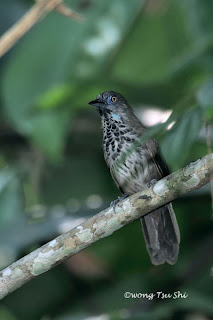Of the nine species of Barbets in Borneo, eight are from the genus Megalaima, which are green with the head and neck gorgeously patterned with vivid reds, blues and yellows, the other is the nondescript Brown Barbet Calorhamphus fuliginosus tertius, which is a brown above and whitish below, with reddish throat.
The main feature of all Megalaima barbets in Borneo is the relentless perisitence of their calls, so much so that after a while, you no longer notice them. Their bills remain closed when calling giving a ventriloquial effect of varying volume.
Yellow-crowned Barbet Megalaima henricii, photo taken in Tawau, Sabah, the ninth and the last barbet of Borneo to be seen for me to complete all the barbets of Borneo.
This is the Yellow-crowned Barbet, ranges from lowland to sub-montane (0 to 1,220m), with an unmistakable call that consists of a roll and four 'tuk' notes, repeated: 'trrrrk-tuk-tuk-tuk-tuk, trrrrk-tuk-tuk-tuk-tuk' and on and on ........
Yellow-crowned Barbet
Although I have seen them all, I have only successfully photographed eight of them, the endemic Mountain Barbet Megalaima monticola was observed in Refflesia Reserve earlier but was unable to take photograph as it was perched right over my head and I could not align my Whimberly head vertically to shoot.
The seven other barbets before this are; (click to link to picture).
* denotes Bornean endemic
Brown Barbet Calorhamphus fuliginosus tertius
Blue-eared Barbet Megalaima australis
Gold-whiskered Barbet Megalaima chrysopogon
*Bornean Barbet Megalaima exima exima
Red-throated Barbet Megalaima mystacophanos
*Golden-naped Barbet Megalaima pulcherrima
Red-crowned Barbet Megalaima rafflesii
The target for 2010 is, therefore, to photograph the Mountain Barbet and complete the collection.
Happy birding.
Photodocument of Wild Birds of Borneo #308
Standard References for my blog














